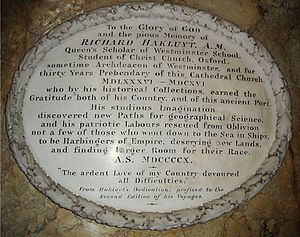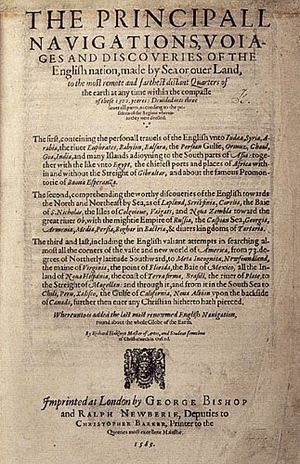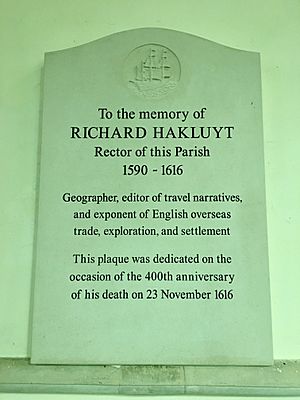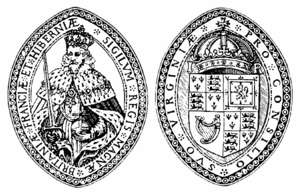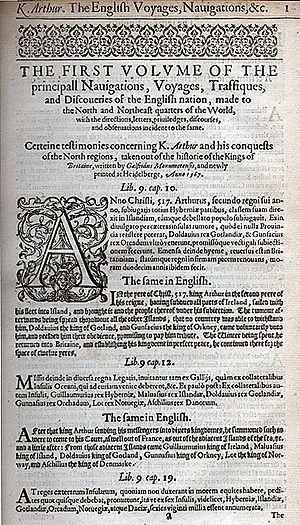Richard Hakluyt facts for kids
Quick facts for kids
Richard Hakluyt
|
|
|---|---|

Hakluyt depicted in stained glass in the west window of the south transept of Bristol Cathedral – Charles Eamer Kempe, c. 1905.
|
|
| Born | 1553 Hereford, Herefordshire; or London, England |
| Died | 23 November 1616 (aged 64) London, England |
| Occupation | Author, editor and translator |
| Period | 1580–1609 |
| Subject | Exploration; geography; travel |
| Signature | |
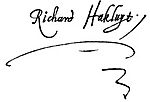 |
|
Richard Hakluyt (1553 – 23 November 1616) was an English writer, editor, and translator. He is famous for encouraging England to set up colonies in North America. He did this through his writings, especially Divers Voyages Touching the Discoverie of America (1582) and The Principal Navigations, Voyages, Traffiques and Discoveries of the English Nation (1589–1600).
Hakluyt went to Westminster School and Christ Church, Oxford. From 1583 to 1588, he worked as a chaplain and secretary for Sir Edward Stafford, who was the English ambassador in France. Hakluyt was also a priest. He held important jobs at Bristol Cathedral and Westminster Abbey. He was also a personal chaplain to Robert Cecil, 1st Earl of Salisbury, a main advisor to Elizabeth I and James I.
Hakluyt was a key person in asking King James I for permission to start a colony in Virginia. This permission was given to the London Company and Plymouth Company (together called the Virginia Company) in 1606. The Hakluyt Society, which publishes old records of voyages and travels, was named after him in 1846.
Contents
Richard Hakluyt's Early Life and School
Richard Hakluyt's family came from Wales. They settled in Herefordshire, England, around the 1200s. His family name might have come from the "Forest of Cluid." Some of his family members became important landowners in Herefordshire.
Richard Hakluyt was born in Eyton, Herefordshire, in 1553. He was the second of four sons. His father, also named Richard Hakluyt, was a member of the Worshipful Company of Skinners, who traded in animal skins and furs. Both his parents died when he was young. His cousin, also named Richard Hakluyt, became his guardian.
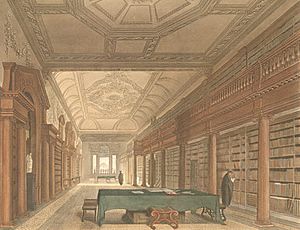
While at Westminster School, young Richard visited his guardian. His guardian showed him "certain bookes of cosmographie, an universall mappe, and the Bible." This made Hakluyt decide to study geography and exploration. In 1570, he went to Christ Church, Oxford, with money from the Skinners' Company. There, he read every book and manuscript he could find about voyages and discoveries.
He earned his first degree in 1574 and his Master of Arts degree in 1577. After that, he started giving public talks about geography. He was the first to show both old and new maps, globes, and other tools used in geography. Hakluyt stayed at Christ Church until 1586, even though he didn't live in Oxford after 1583.
In 1578, Hakluyt became a priest. He also started getting money from the Worshipful Company of Clothworkers to study religion. This money was meant to stop in 1583, but William Cecil, 1st Baron Burghley, helped him get it extended until 1586 so he could continue his geography research.
Working at the English Embassy in Paris
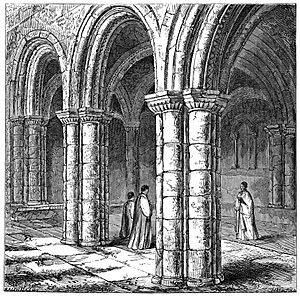
Hakluyt's first book was Divers Voyages Touching the Discoverie of America (1582). This book made him known to important people like Lord Howard of Effingham and Sir Edward Stafford.
When he was 30, Hakluyt was chosen to be a chaplain and secretary for Ambassador Stafford in Paris in 1583. His job was to gather information about what Spain and France were doing, especially about their discoveries in America. Even though this was his only trip to Continental Europe, he was upset to hear people in Paris talk about how limited the English were in travel.
While in Paris, Hakluyt wrote an important work called A Particuler Discourse Concerninge the Greate Necessitie and Manifolde Commodyties That Are Like to Growe to This Realme of Englande by the Westerne Discoueries Lately Attempted (1584). Sir Walter Raleigh asked him to write this. The original paper was lost for almost 300 years and was first published in 1877.
In 1584, Hakluyt visited England and gave a copy of this Discourse to Elizabeth I. He wanted to convince her to support England's plan to set up colonies in North America. In May 1585, the Queen promised him a job at Bristol Cathedral. He got this job in 1585 or 1586 and kept it until he died.
Other works by Hakluyt during his time in Paris were mostly translations of other books. He added his own introductions and dedications. These writings, along with a few letters, are the only personal writings we have from him. He helped publish a French journal about Florida in 1586. He then translated it into English as A Notable Historie Containing Foure Voyages Made by Certayne French Captaynes unto Florida (1587). In the same year, he published an edition of Peter Martyr d'Anghiera's De Orbe Nouo Decades Octo. This book included a very rare map, which was the first to show the name "Virginia."
Coming Back to England
In 1588, Hakluyt returned to England after almost five years in France. In 1589, he published the first version of his most important work, The Principall Navigations, Voiages and Discoveries of the English Nation. For this book, he used stories from people who had actually been on the voyages. In the introduction, he announced that the first globe made in England by Emery Molyneux would be published.
Between 1598 and 1600, the final, much larger edition of The Principal Navigations, Voiages, Traffiques and Discoueries of the English Nation came out in three volumes. In the dedication of the second volume (1599) to his supporter, Robert Cecil, 1st Earl of Salisbury, Hakluyt strongly pushed for colonizing Virginia. Some copies of this huge work include a very rare map. This map was the first in England to use the Mercator projection correctly. The historian James Anthony Froude called Hakluyt's great collection "the Prose Epic of the modern English nation."
On 20 April 1590, Hakluyt became the head of the church in Wetheringsett-cum-Brockford, Suffolk. He held this job until he died and lived in Wetheringsett often during the 1590s. In 1599, he became an advisor to the new East India Company. In 1601, he edited a translation of Antonio Galvão's The Discoveries of the World from Portuguese.
Later Life and Legacy
In the late 1590s, Hakluyt became a close associate and personal chaplain of Robert Cecil, 1st Earl of Salisbury. Cecil was a powerful advisor to Queen Elizabeth I and King James I. He rewarded Hakluyt by making him a church official at Westminster Abbey in 1602. The next year, Hakluyt was elected archdeacon of the Abbey. These religious jobs show how important spiritual ideas were in Hakluyt's writings about exploration and England's relationships with other countries.
Hakluyt was married twice, around 1594 and again in 1604. In 1604, he was also described as a chaplain of the Savoy Hospital. His will mentions that he lived there until his death. He was also called a Doctor of Divinity (D.D.).
Hakluyt was a main supporter of the Virginia Company of London and became a director in 1589. In 1605, he secured the future church position in Jamestown, which was planned to be the capital of the Virginia colony. When the colony was finally started in 1607, he sent Robert Hunt to be its chaplain. In 1606, he was the main person who asked King James I for permission to colonize Virginia. This permission was granted on April 10, 1606.
His last published work was a translation of Hernando de Soto's discoveries in Florida, called Virginia Richly Valued (1609). This book was meant to encourage people to support the new colony of Virginia. The historian William Robertson said that "England is more indebted for its American possessions than to any man of that age" because of Hakluyt.
Hakluyt also prepared an English translation of a book by Dutch lawyer Hugo Grotius called Mare Liberum (1609). This book argued that the Dutch had the right to trade freely in the East Indies. This went against Spain and Portugal's claims that they owned the seas. Hakluyt's translation was probably meant to support England's right to trade and encourage people to settle in Virginia. Grotius argued that the Pope's decision in 1493, which divided the oceans between Spain and Portugal, did not give Spain the right to claim North America. He said that actually settling a place was more important. This helped England, as they had settled Virginia, not Spain. Grotius also argued that all seas should be open for everyone to travel, which was useful for the route from England to Virginia, as Portugal claimed those seas. However, Hakluyt's translation was not published during his lifetime. It was finally published in 2004 as The Free Sea.
In 1591, Hakluyt inherited family property. By the time he died, he had saved a good amount of money from his various jobs. Sadly, his only son wasted this money.
Hakluyt died on 23 November 1616, likely in London. He was buried on 26 November in Westminster Abbey. Some of his writings were later used by Samuel Purchas in his book Pilgrimes (1625–1626). Other notes are kept at the University of Oxford.
Hakluyt is mostly remembered for his efforts to promote and support English settlement in North America through his writings. His works were a great source of ideas for famous writers like William Shakespeare. Hakluyt also encouraged others to write about geography and history. For example, he suggested that Robert Parke translate a book about China and that John Pory translate a book about Africa.
Richard Hakluyt's Legacy
The Hakluyt Society was started in 1846. Its goal is to print rare and unpublished stories of voyages and travels. It still publishes new books every year.
A large, detailed edition of Hakluyt's Principal Navigations is being prepared by the Hakluyt Edition Project for Oxford University Press.
Westminster School named a house after him to honor him as a former student.
Richard Hakluyt's Works
Books He Wrote
- Divers Voyages Touching the Discoverie of America and the Ilands Adjacent unto the Same, Made First of All by Our Englishmen and Afterwards by the Frenchmen and Britons: With Two Mappes Annexed Hereunto (London, 1582)
- A Particuler Discourse Concerninge the Greate Necessitie and Manifolde Commodyties That Are Like to Growe to This Realme of Englande by the Westerne Discoueries Lately Attempted, Written in the Yere 1584 (1584)
- The Principall Navigations, Voiages, and Discoveries of the English Nation (London, 1589)
- The Principall Nauigations, Voyages, Traffiques, and Discoueries of the English Nation (London, 1598–1600) – This was a much larger, updated version in three volumes.
Books He Edited and Translated
- A Notable Historie Containing Foure Voyages made by Certaine French Captaynes unto Florida (London, 1587) – Translated from René de Laudonnière.
- De Orbe Nouo Petri Martyris Anglerii Mediolanensis Protonotarii et Caroli Quinti Senatoris Decades Octo (Paris, 1587) – Edited from Peter Martyr d'Anghiera.
- The Discoveries of the World from Their First Originall unto the Yeer ... 1555 (London, 1601) – Edited from Antonio Galvão.
- Virginia Richly Valued, by the Description of the Maine Land of Florida, Her Next Neighbour (London, 1609) – Translated from Ferdinando de Soto.
- The Free Sea (Indianapolis, Ind., 2004) – Translated from Hugo Grotius. This translation was prepared by Hakluyt but published much later.
See also
 In Spanish: Richard Hakluyt para niños
In Spanish: Richard Hakluyt para niños
- Étienne Bellenger


